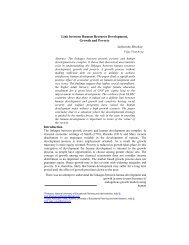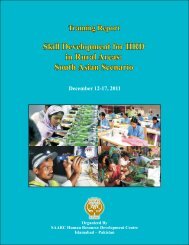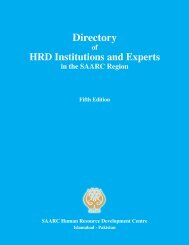Training Report: Millennium Development Goals in the SAARC Region
Training Report: Millennium Development Goals in the SAARC Region
Training Report: Millennium Development Goals in the SAARC Region
Create successful ePaper yourself
Turn your PDF publications into a flip-book with our unique Google optimized e-Paper software.
Work<strong>in</strong>g Sessions<br />
India’s trend of <strong>the</strong> proportion of underweight children below 3 years of age shows that India is go<strong>in</strong>g slow <strong>in</strong><br />
elim<strong>in</strong>at<strong>in</strong>g <strong>the</strong> effect of malnourishment. Accord<strong>in</strong>g to <strong>the</strong> official estimates, <strong>the</strong> proportion of underweight<br />
children has decl<strong>in</strong>ed by 3 percentage po<strong>in</strong>ts dur<strong>in</strong>g 1998-99 to 2005-06, from about 43% to about 40% and at<br />
this rate of decl<strong>in</strong>e is expected to come down to about 33% only by 2015. Nutrition Programs <strong>in</strong>clude:<br />
National Mid-Day Meal Scheme; Integrated Child <strong>Development</strong> Scheme or ICDS (1975). Food Security<br />
Programs for <strong>the</strong> poor <strong>in</strong>clude: Targeted Public Distribution Scheme (TPDS); Antyodaya Anna Yojana;<br />
Annapurna Scheme; and National Food Security Bill.<br />
By <strong>the</strong> measure of Net Enrolment Ratio (NER) <strong>in</strong> primary education, <strong>the</strong> country has already crossed by 2008-<br />
09, <strong>the</strong> 95% cut-off l<strong>in</strong>e regarded as <strong>the</strong> marker value for achiev<strong>in</strong>g 2015 target of universal primary education<br />
for all children aged 6-10 years. Primary enrolment of 6-10 year old children has improved from 83% <strong>in</strong> <strong>the</strong><br />
year 2000 to over 95% <strong>in</strong> 2007-08. The country is on <strong>the</strong> track to achieve cent percent primary education for<br />
children <strong>in</strong> <strong>the</strong> primary school<strong>in</strong>g age of 6-10 years ahead of 2015. Sarva Shiksha Abhiyan (SSA) guarantees<br />
free and compulsory education to <strong>the</strong> children of 6 to 14year age group as a fundamental right. The survival<br />
rate at primary level up to Grade V has <strong>in</strong>creased to 76% <strong>in</strong> 2008-09. India is likely to atta<strong>in</strong> 100% Youth<br />
literacy by 2015.<br />
The target for elim<strong>in</strong>at<strong>in</strong>g gender disparity <strong>in</strong> primary and secondary enrolment by 2005 has not been<br />
achieved <strong>in</strong> India as per <strong>the</strong> available data for Gender Parity Index (GPI) for Enrolment, <strong>in</strong> <strong>the</strong> sense that<br />
though almost perfect parity was atta<strong>in</strong>ed <strong>in</strong> <strong>the</strong> primary level of enrolment, it was not so <strong>in</strong> secondary level.<br />
However, by <strong>the</strong> cut-off l<strong>in</strong>e for achievement as <strong>in</strong>ternationally recognized, <strong>the</strong> target has been achieved for<br />
primary grade by 2007-08. The rates of <strong>in</strong>crease <strong>in</strong> GPI signify India’s on <strong>the</strong> track progress to achiev<strong>in</strong>g<br />
gender parity <strong>in</strong> enrolment by 2015, even for secondary grade. Sarva Shiksha Abhiyan or ‘Education for All’<br />
program recognizes that ensur<strong>in</strong>g girl’s education requires changes not only <strong>in</strong> <strong>the</strong> education system but also<br />
<strong>in</strong> societal norms and attitudes. The ratio of literate women to men <strong>in</strong> <strong>the</strong> age group 15-24 years stands at 0.88<br />
<strong>in</strong> 2007-08. The ratio of literate women to men <strong>in</strong> <strong>the</strong> age group 15-24 years tends to exceed by 2015, imply<strong>in</strong>g<br />
reach<strong>in</strong>g a state of gender disparity aga<strong>in</strong>st male youths <strong>in</strong> literacy by 2015. In India, <strong>the</strong> share of women <strong>in</strong><br />
wage employment <strong>in</strong> <strong>the</strong> non-agricultural sector is slow. The percentage share of females <strong>in</strong> wage<br />
employment <strong>in</strong> <strong>the</strong> non- agricultural sector, stood at 18.6% dur<strong>in</strong>g 2009-10. It is projected that with this rate of<br />
progression, <strong>the</strong> share of women <strong>in</strong> wage employment can reach a level of about 23.1% by 2015.<br />
The Under-Five Mortality Rate (U5MR) at national level has decl<strong>in</strong>ed dur<strong>in</strong>g <strong>the</strong> last decade. U5MR <strong>in</strong> India<br />
for <strong>the</strong> year 2010 stands at 59 and it varies from 66 <strong>in</strong> rural areas to 38 <strong>in</strong> urban areas. To reduce U5MR to 42<br />
per thousand live births5 by 2015, India tends to reach near to 52 by that year, miss<strong>in</strong>g <strong>the</strong> target by 10<br />
percentage po<strong>in</strong>ts. Infant Mortality Rate (IMR) has decl<strong>in</strong>ed by six po<strong>in</strong>ts between 2008 and 2010 with IMR<br />
at national level be<strong>in</strong>g 47 <strong>in</strong> 2010. With <strong>the</strong> present improved trend due to sharp fall dur<strong>in</strong>g 2008-09, <strong>the</strong><br />
national level estimate of IMR is likely to be 44 aga<strong>in</strong>st <strong>the</strong> MDG target of 27 <strong>in</strong> 2015. The national level<br />
measure of <strong>the</strong> proportion of one-year old (12-23 months) children immunized aga<strong>in</strong>st measles has registered<br />
an <strong>in</strong>crease from 42.2% <strong>in</strong> 1992-93 to 74.1% <strong>in</strong> 2009. India is expected to cover about 89% children <strong>in</strong> <strong>the</strong> age<br />
group 12-23 months for immunization aga<strong>in</strong>st measles by 2015. Thus, India is likely to fall short of universal<br />
immunization of one year olds aga<strong>in</strong>st measles by about 11 percentage po<strong>in</strong>ts <strong>in</strong> 2015. To reduce child<br />
mortality rate, child health <strong>in</strong>terventions under <strong>the</strong> Reproductive and Child Health (RCH) Program <strong>in</strong>clude:<br />
Integrated Management of Neonatal and Childhood Illnesses (IMNCI); Promotion of Infant and Young Child<br />
Feed<strong>in</strong>g; Oral Rehydration Therapy (ORT) Program; and Acute Respiratory Infections (ARI) Control.<br />
India has recorded a sharp decl<strong>in</strong>e <strong>in</strong> <strong>the</strong> Maternal Mortality Ratio (MMR) by 35% from 327 <strong>in</strong> 1999-2001 to<br />
212 <strong>in</strong> 2007-09. India tends to reach MMR of 139 per 100,000 live births by 2015, fall<strong>in</strong>g short by 30 po<strong>in</strong>ts.<br />
The coverage of deliveries by skilled personnel has <strong>in</strong>creased almost from 33% <strong>in</strong> 1990 to 52% dur<strong>in</strong>g 2007-<br />
08. With <strong>the</strong> exist<strong>in</strong>g rate of <strong>in</strong>crease <strong>in</strong> deliveries by skilled personnel, <strong>the</strong> likely achievement by 2015 is only<br />
to 62%, which is far short of <strong>the</strong> targeted universal coverage. In order to improve maternal health, maternal<br />
health care facilities <strong>in</strong>clude: ante-natal care; natal care; post-natal care.<br />
8
















